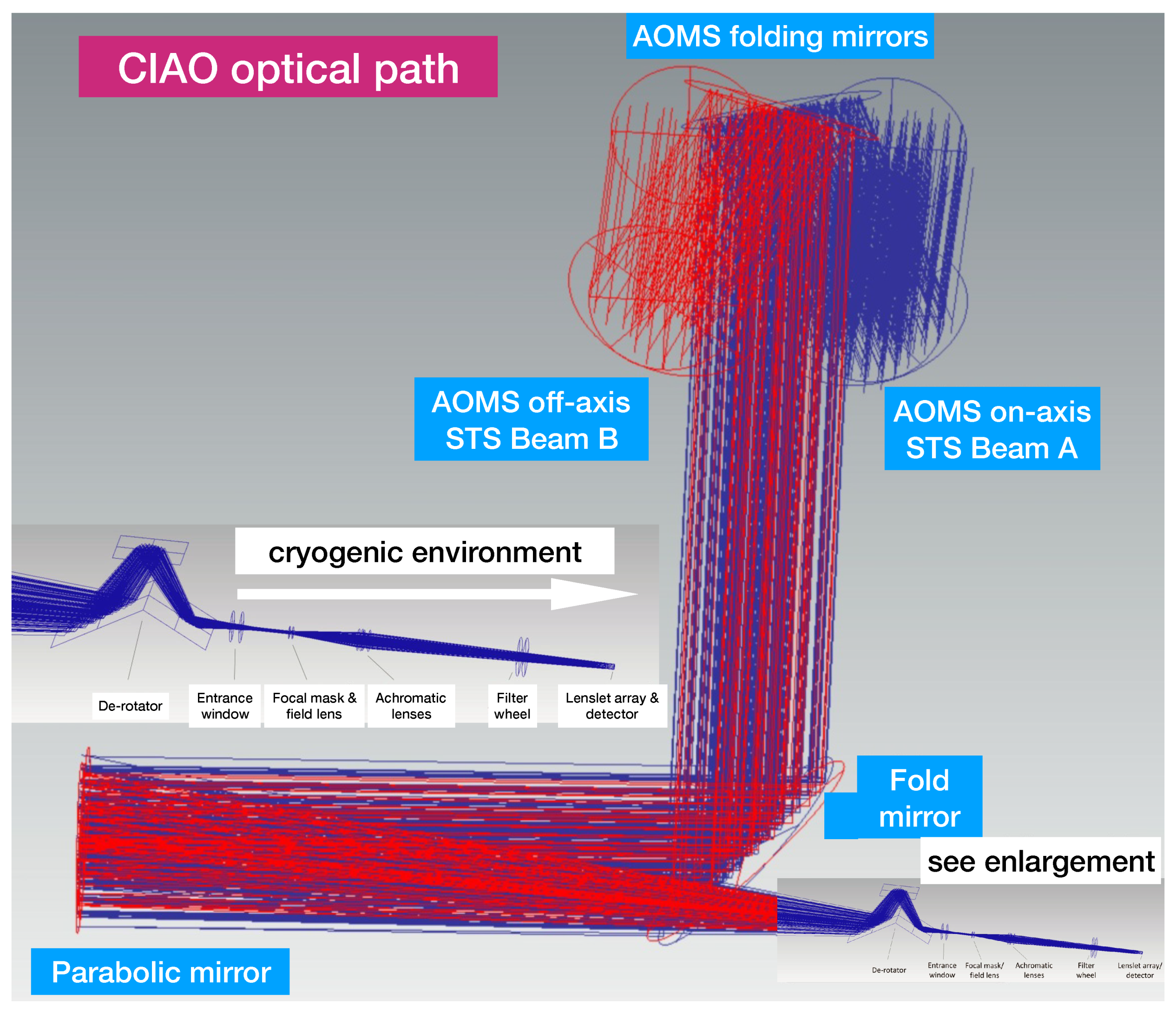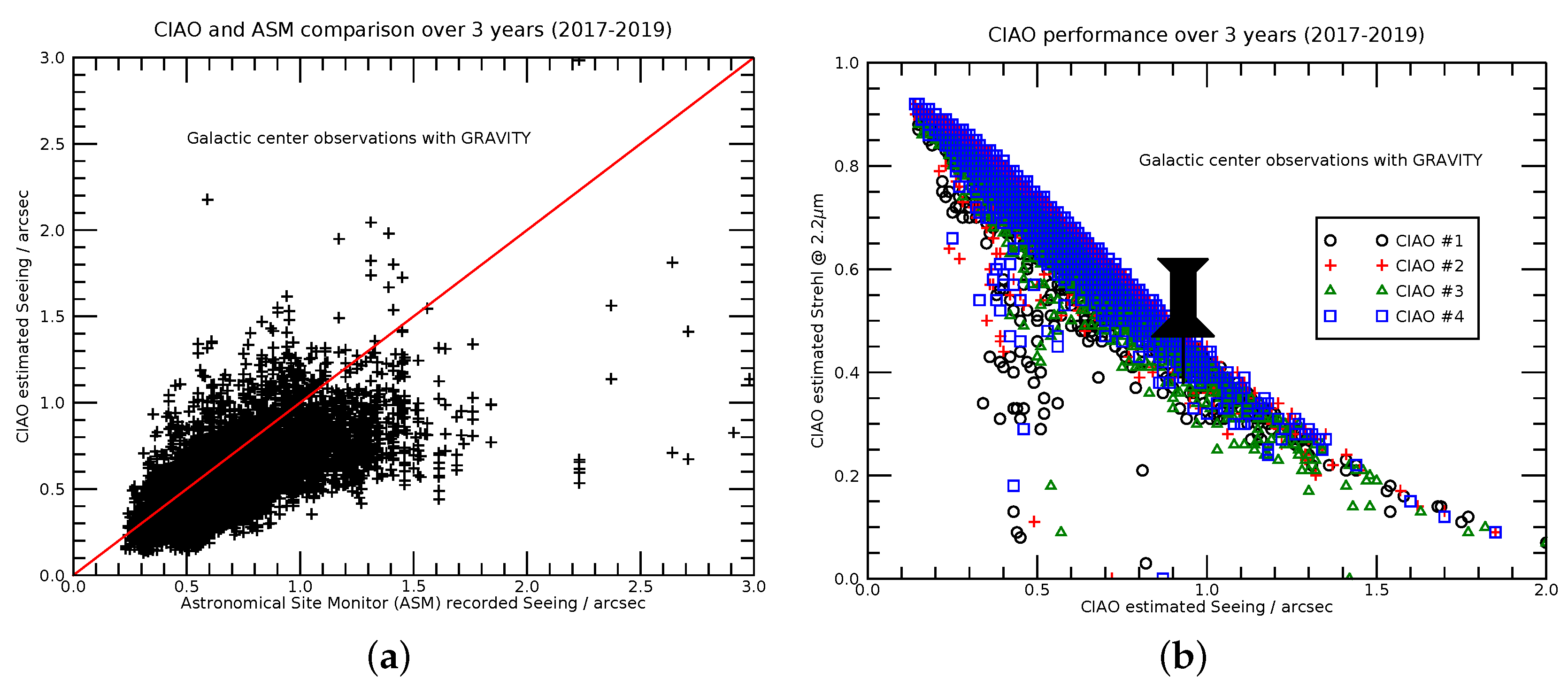Infrared Wavefront Sensing for Adaptive Optics Assisted Galactic Center Observations with the VLT Interferometer and GRAVITY: Operation and Results
Abstract
1. Introduction
2. Galactic Center Observations with GRAVITY: Requirements for CIAO
- provide wavefront correction.
- provide near infrared wavefront sensing—allow for off-axis wavefront sensing.
3. Overview of the CIAO System
4. The SAPHIRA Detector
5. Statistical Review of Three Years of CIAO Operation
6. Summary
Author Contributions
Funding
Conflicts of Interest
References
- Genzel, R.; Eisenhauer, F.; Gillessen, S. The Galactic Center massive black hole and nuclear star cluster. Rev. Mod. Phys. 2010, 82, 3121–3195. [Google Scholar] [CrossRef]
- Gillessen, S.; Eisenhauer, F.; Trippe, S.; Alexander, T.; Genzel, R.; Martins, F.; Ott, T. Monitoring Stellar Orbits Around the Massive Black Hole in the Galactic Center. Astrophys. J. 2009, 692, 1075–1109. [Google Scholar] [CrossRef]
- Doeleman, S.S.; Weintroub, J.; Rogers, A.E.; Plambeck, R.; Freund, R.; Tilanus, R.P.; Friberg, P.; Ziurys, L.M.; Moran, J.M.; Corey, B.; et al. Event-horizon-scale structure in the supermassive black hole candidate at the Galactic Centre. Nature 2008, 455, 78–80. [Google Scholar] [CrossRef] [PubMed]
- Lu, R.S.; Krichbaum, T.P.; Roy, A.L.; Fish, V.L.; Doeleman, S.S.; Johnson, M.D.; Akiyama, K.; Psaltis, D.; Alef, W.; Asada, K.; et al. Detection of Intrinsic Source Structure at 3 Schwarzschild Radii with Millimeter-VLBI Observations of SAGITTARIUS A*. Astrophys. J. 2018, 859, 60. [Google Scholar] [CrossRef]
- Woillez, J.; Darré, P.; Egner, S.; Gonté, F.; Haubois, X.; Mérand, A.; Schuhler, N.; Abad, J.A.; Abuter, R.; Aller-Carpentier; et al. VLTI status update: Three years into the second generation. Proc. SPIE 2018, 10701, 1070103. [Google Scholar] [CrossRef]
- Eisenhauer, F.; Perrin, G.; Brandner, W.; Straubmeier, C.; Perraut, K.; Amorim, A.; Schöller, M.; Gillessen, S.; Kervella, P.; Benisty, M.; et al. GRAVITY: Observing the Universe in Motion. Messenger 2011, 143, 16–24. [Google Scholar]
- Eisenhauer, F.; Perrin, G.; Rabien, S.; Eckart, A.; Lena, P.; Genzel, R.; Abuter, R.; Paumard, T.; Brandner, W. GRAVITY: The AO-Assisted, Two-Object Beam-Combiner Instrument for the VLTI. In The Power of Optical/IR Interferometry: Recent Scientific Results and 2nd Generation; Richichi, A., Delplancke, F., Paresce, F., Chelli, A., Eds.; Springer: Berlin/Heidelberg, Germany, 2008; p. 431. [Google Scholar] [CrossRef]
- Gravity Collaboration; Accardo, M.; Amorim, A.; Anugu, N.; Avila, G.; Azouaoui, N.; Benisty, M.; Berger, J.P.; Blind, N.; Bonnet, H.; et al. First light for GRAVITY: Phase referencing optical interferometry for the Very Large Telescope Interferometer. Astron. Astrophys. 2017, 602, A94. [Google Scholar] [CrossRef]
- Gravity Collaboration; Abuter, R.; Amorim, A.; Anugu, N.; Bauböck, M.; Benisty, M.; Berger, J.P.; Blind, N.; Bonnet, H.; Brandner, W.; et al. Detection of the gravitational redshift in the orbit of the star S2 near the Galactic centre massive black hole. Astron. Astrophys. 2018, 615, L15. [Google Scholar] [CrossRef]
- Gravity Collaboration; Abuter, R.; Amorim, A.; Bauböck, M.; Berger, J.P.; Bonnet, H.; Brandner, W.; Clénet, Y.; Coudé Du Foresto, V.; de Zeeuw, P.T.; et al. Detection of orbital motions near the last stable circular orbit of the massive black hole SgrA*. Astron. Astrophys. 2018, 618, L10. [Google Scholar] [CrossRef]
- Gravity Collaboration; Abuter, R.; Amorim, A.; Bauböck, M.; Berger, J.P.; Bonnet, H.; Brandner, W.; Clénet, Y.; Coudé Du Foresto, V.; de Zeeuw, P.T.; et al. Spatially resolved rotation of the broad-line region of a quasar at sub-parsec scale. Nature 2018, 563, 657–660. [Google Scholar] [CrossRef]
- Schöller, M. The Very Large Telescope Interferometer: Current facility and prospects. New Astron. Rev. 2007, 51, 628–638. [Google Scholar] [CrossRef]
- GRAVITY Collaboration; Abuter, R.; Accardo, M.; Adler, T.; Amorim, A.; Anugu, N.; Ávila, G.; Bauböck, M.; Benisty, M.; Berger, J.-P.; et al. GRAVITY Science. Messenger 2019, 178, 19–49. [Google Scholar] [CrossRef]
- Yang, P.; Hippler, S.; Deen, C.P.; Brandner, W.; Clénet, Y.; Henning, T.; Huber, A.; Kendrew, S.; Lenzen, R.; Pfuhl, O.; et al. Characterization of the transmitted near-infrared wavefront error for the GRAVITY/VLTI Coudé Infrared Adaptive Optics System. Opt. Express 2013, 21, 9069. [Google Scholar] [CrossRef] [PubMed]
- Pfuhl, O.; Haug, M.; Eisenhauer, F.; Kellner, S.; Haussmann, F.; Perrin, G.; Gillessen, S.; Straubmeier, C.; Ott, T.; Rousselet-Perraut, K.; et al. The fiber coupler and beam stabilization system of the GRAVITY interferometer. Proc. SPIE 2014, 9146, 914623. [Google Scholar] [CrossRef]
- Perraut, K.; Jocou, L.; Berger, J.P.; Chabli, A.; Cardin, V.; Chamiot-Maitral, G.; Delboulbé, A.; Eisenhauer, F.; Gambérini, Y.; Gillessen, S.; et al. Single-mode waveguides for GRAVITY. I. The cryogenic 4-telescope integrated optics beam combiner. Astron. Astrophys. 2018, 614, A70. [Google Scholar] [CrossRef]
- Clénet, Y.; Rousset, G.; Eisenhauer, F.; Gillessen, S.; Perrin, G.; Amorim, A.; Brandner, W.; Perraut, K.; Straubmeier, C. Dimensioning the Gravity adaptive optics wavefront sensor. Proc. SPIE 2010, 7736, 7364A. [Google Scholar] [CrossRef]
- Scheithauer, S.; Brandner, W.; Deen, C.; Adler, T.; Bonnet, H.; Bourget, P.; Chemla, F.; Clenet, Y.; Delplancke, F.; Ebert, M.; et al. CIAO: Wavefront sensors for GRAVITY. Proc. SPIE 2016, 9909, 99092L. [Google Scholar] [CrossRef]
- Deen, C.; Kolb, J.; Oberti, S.; Bonnet, H.; Müller, E.; Hubert, Z.; Zins, G.; Delplancke, F.; Haguenauer, P.; Pettazzi, L.; et al. System tests and on-sky commissioning of the GRAVITY-CIAO wavefront sensors. Proc. SPIE 2016, 9909, 99092M. [Google Scholar] [CrossRef]
- Kendrew, S.; Hippler, S.; Brandner, W.; Clénet, Y.; Deen, C.; Gendron, E.; Huber, A.; Klein, R.; Laun, W.; Lenzen, R.; et al. GRAVITY Coudé Infrared Adaptive Optics (CIAO) system for the VLT Interferometer. Proc. SPIE 2012, 8446, 84467W. [Google Scholar] [CrossRef]
- Hippler, S.; Brandner, W.; Clénet, Y.; Hormuth, F.; Gendron, E.; Henning, T.; Klein, R.; Lenzen, R.; Meschke, D.; Naranjo, V.; et al. Near-infrared wavefront sensing for the VLT interferometer. Proc. SPIE 2008, 7015, 701555. [Google Scholar] [CrossRef]
- Nijenhuis, J.R.; Giesen, P.T.M. A major step forward back in time with the ESO Star Separator system. Proc. SPIE 2005, 5877, 24–30. [Google Scholar] [CrossRef]
- Nijenhuis, J.; Visser, H.; de Man, H.; Dekker, B.; Mekking, J.; Kamphues, F. Simultaneous observation of two stars using the PRIMA Star Separator. Proc. SPIE 2008, 7013, 70133F. [Google Scholar] [CrossRef]
- Dai, X.; Hippler, S.; Gendron, E. Experiments of two pupil lateral motion tracking algorithms using a Shack-Hartmann sensor. J. Mod. Opt. 2017, 64, 127–137. [Google Scholar] [CrossRef]
- Finger, G.; Baker, I.; Alvarez, D.; Ives, D.; Mehrgan, L.; Meyer, M.; Stegmeier, J.; Weller, H.J. SAPHIRA detector for infrared wavefront sensing. Proc. SPIE 2014, 9148, 914817. [Google Scholar] [CrossRef]
- Finger, G.; Baker, I.; Alvarez, D.; Dupuy, C.; Ives, D.; Meyer, M.; Mehrgan, L.; Stegmeier, J.; Weller, H.J. Sub-electron read noise and millisecond full-frame readout with the near infrared eAPD array SAPHIRA. Proc. SPIE 2016, 9909, 990912. [Google Scholar] [CrossRef]
- Mehrgan, L.H.; Finger, G.; Eisenhauer, F.; Panduro, J. GRAVITY detector systems. Proc. SPIE 2016, 9907, 99072F. [Google Scholar] [CrossRef]
- Atkinson, D.E.; Hall, D.N.; Baker, I.M.; Goebel, S.B.; Jacobson, S.M.; Lockhart, C.; Warmbier, E.A. Next-generation performance of SAPHIRA HgCdTe APDs. Proc. SPIE 2016, 9915, 99150N. [Google Scholar] [CrossRef]
- Finger, G.; Baker, I.; Alvarez, D.; Eisenhauer, F.; Hechenblaikner, G.; Ives, D.; Mehrgan, L.; Meyer, M.; Stegmeier, J.; Weller, H.J. On-sky performance verification of near infrared eAPD technology for wavefront sensing at ground based telescopes, demonstration of e-APD pixel performance to improve the sensitivity of large science focal planes and possibility to use this technology in space. Proc. SPIE 2019, 11180, 111806L. [Google Scholar] [CrossRef]
- Goebel, S.B.; Jacobson, S.M.; Lockhart, C.; Warmbier, E.A. Overview of the SAPHIRA detector for adaptive optics applications. J. Astron. Telesc. Instrum. Syst. 2018, 4, 026001. [Google Scholar] [CrossRef]
- Fowler, A.M.; Gatley, I. Demonstration of an Algorithm for Read-Noise Reduction in Infrared Arrays. Astrophys. J. 1990, 353, L33. [Google Scholar] [CrossRef]
- Baker, I.; Maxey, C.; Hipwood, L.; Barnes, K. Leonardo (formerly Selex ES) infrared sensors for astronomy: Present and future. Proc. SPIE 2016, 9915, 991505. [Google Scholar] [CrossRef]
- Lacour, S.; Dembet, R.; Abuter, R.; Fédou, P.; Perrin, G.; Choquet, É.; Pfuhl, O.; Eisenhauer, F.; Woillez, J.; Cassaing, F.; et al. The GRAVITY fringe tracker. Astron. Astrophys. 2019, 624, A99. [Google Scholar] [CrossRef]
- White, M.H.; Lampe, D.R.; Blaha, F.C.; Mack, I.A. Characterization of surface channel CCD image arrays at low light levels. IEEE J. Solid-State Circuits 1974, 9, 1–12. [Google Scholar] [CrossRef]
- Alessandri, C.; Abusleme, A.; Guzman, D.; Passalacqua, I.; Alvarez-Fontecilla, E.; Guarini, M. Optimal CCD readout by digital correlated double sampling. Mon. Not. R. Astron. Soc. 2016, 455, 1443–1450. [Google Scholar] [CrossRef]
- Cruz de la Torre, C.; de Vicente Albendea, J. Digital correlated double sampling CCD readout characterization. Proc. SPIE 2018, 10709, 1070920. [Google Scholar] [CrossRef]
- Fusco, T.; Ageorges, N.; Rousset, G.; Rabaud, D.; Gendron, E.; Mouillet, D.; Lacombe, F.; Zins, G.; Charton, J.; Lidman, C.; et al. NAOS performance characterization and turbulence parameters estimation using closed-loop data. Proc. SPIE 2004, 5490, 118–129. [Google Scholar] [CrossRef]
- Snyder, A.; Srinath, S.; Macintosh, B.; Roodman, A. Temporal characterization of Zernike decomposition of atmospheric turbulence. Proc. SPIE 2016, 9906, 990642. [Google Scholar] [CrossRef]








| Guide Star Magnitude in K-Band | Guide Star Separation from Science Target [Arcsec] | Telescope Zenith Angle [Degrees] | Strehl Number at = 2.2 m [%] | Residual 2-Axis Image Jitter [mas rms] |
|---|---|---|---|---|
| 7 a | 7 | 30 | 25 | 10 |
| 7 | 0 | 30 | 35 | 10 |
| 10 | 0 | 30 | 10 | 22 |
| Saphira Detector Number | #1 | #2 | #3 | #4 | Comment |
|---|---|---|---|---|---|
| Readout noise [ rms/pixel ] a | 1.24 | 0.95 | 1.17 | 0.96 | Fowler-8 b |
| Bad pixels [pixel/detector] | 63 | 39 | 78 | 40 | CDS c |
| Bad pixel in CIAO sub-region | 3 | 1 | 0 | 2 | |
| Detector gain [/ADU] | 0.380 | 0.387 | 0.388 | 0.395 | CDS c |
| eAPD gain [/] | 30.11 | 30.64 | 26.40 | 27.15 | |
| Dark current [/pixel/s] | 478.6 | 485.15 | 631.1 | 630.85 | CDS c |
| Quantum efficiency@90 K [/] | 60%, 67% | H-band, K-band | |||
© 2020 by the authors. Licensee MDPI, Basel, Switzerland. This article is an open access article distributed under the terms and conditions of the Creative Commons Attribution (CC BY) license (http://creativecommons.org/licenses/by/4.0/).
Share and Cite
Hippler, S.; Brandner, W.; Scheithauer, S.; Kulas, M.; Panduro, J.; Bizenberger, P.; Bonnet, H.; Deen, C.; Delplancke-Ströbele, F.; Eisenhauer, F.; et al. Infrared Wavefront Sensing for Adaptive Optics Assisted Galactic Center Observations with the VLT Interferometer and GRAVITY: Operation and Results. Instruments 2020, 4, 20. https://doi.org/10.3390/instruments4030020
Hippler S, Brandner W, Scheithauer S, Kulas M, Panduro J, Bizenberger P, Bonnet H, Deen C, Delplancke-Ströbele F, Eisenhauer F, et al. Infrared Wavefront Sensing for Adaptive Optics Assisted Galactic Center Observations with the VLT Interferometer and GRAVITY: Operation and Results. Instruments. 2020; 4(3):20. https://doi.org/10.3390/instruments4030020
Chicago/Turabian StyleHippler, Stefan, Wolfgang Brandner, Silvia Scheithauer, Martin Kulas, Johana Panduro, Peter Bizenberger, Henry Bonnet, Casey Deen, Françoise Delplancke-Ströbele, Frank Eisenhauer, and et al. 2020. "Infrared Wavefront Sensing for Adaptive Optics Assisted Galactic Center Observations with the VLT Interferometer and GRAVITY: Operation and Results" Instruments 4, no. 3: 20. https://doi.org/10.3390/instruments4030020
APA StyleHippler, S., Brandner, W., Scheithauer, S., Kulas, M., Panduro, J., Bizenberger, P., Bonnet, H., Deen, C., Delplancke-Ströbele, F., Eisenhauer, F., Finger, G., Hubert, Z., Kolb, J., Müller, E., Pallanca, L., Woillez, J., Zins, G., & GRAVITY Collaboration. (2020). Infrared Wavefront Sensing for Adaptive Optics Assisted Galactic Center Observations with the VLT Interferometer and GRAVITY: Operation and Results. Instruments, 4(3), 20. https://doi.org/10.3390/instruments4030020






